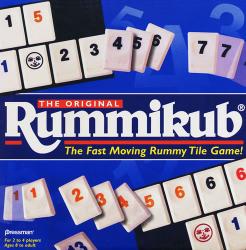Rummy Cube

Rummy classic game using tiles. Drop a tile on the top of another for creating runs. Drop 30 points for initial drop. Rearrange tiles on the table as you wish, as long as the table stays valid. Touch instructions for full instructions. The beginning of each Rummikub game may seem slow, but as the table builds up with sets, more and more manipulations are possible. In the early stages of the game it may be a good idea to keep some tiles on your rack, so that the other players 'open up' the table and provide more manipulation opportunities for you. Rummy classic game using tiles. Drop a tile on the top of another for creating runs. Play against 1, 2 or 3 players (on iPad, just 1 on iPhone). Or, play and chat online, over the internet, against another player. Drop 30 points for initial drop. Rearrange tiles on the table as you wish, as long. Play Rummikub online and experience the game conquering the world. Rummikub Tutorial Rummikub Twist Tutorial Setup All the Rummikub tiles are placed face down in the center of all players. Each player draws 14 tiles to start. The remaining tiles are set aside as a draw pile. Objective: The object of the game is to be the first player to get rid of all your.
The Rules of Rummikub
The rules of Rummikub are fairly simple to understand. The biggest issue with the game doesn't come from complicated game play or strategies; it lies simply in remembering what you can and can't do on a turn. Much like the card games gin, rummy and even solitaire, it's not a lack of expertise that will cause a loss. More likely, you'll find yourself in trouble if you're distracted and missing opportunities right in front of you.
When you first sit down to play Rummikub (two to four players are recommended), you'll dump the numbered, multi-colored tiles on the table face-down. Each player will draw one tile; the highest number goes first, and the 1 tile is always low. (Return those tiles randomly to the table.) Each player will then draw 14 tiles from the table, placing them on their rack; whatever is left forms the pool. On the first turn, each player will attempt to make a set of one or more groups or runs that adds up to at least 30 points.
Advertisement
Advertisement

A group is formed when three or four tiles of the same numbers are put together; like suits in a deck of cards, each number will have a different color. A run is formed when three or more numbers of the same color are played together. Playing a group or a run makes a set (sometimes called a meld). So on your first turn, you must lay either groups or runs that add up to at least 30 points. If your tiles aren't cooperating, no worries: You can take a tile from the pool in the hopes it'll help you snag a 30-point set to get you in the game. You can't play the drawn tile until the next turn, however — this goes for any tile drawn during the game.
From there, it's your job on every turn to scope out places where your tiles can add to a run or a group. This is called melding. A few ways to meld:


- Add a tile to an existing run or group.
- Take the fourth tile from a run or group to complete your own set or add a fourth to another group and take another tile to create a new set.
- Split a run. For instance, a run of 4, 5, 6, 7, 8 is on the table. You take a six from your rack and create a 4, 5, 6 run and make the remaining 6, 7, 8 its own run.
The object of the game is to place all your tiles on the table as part of a set. Once someone does that, that person can proclaim 'Rummikub.' The losers add up the value of the tiles they're still holding on their racks, and that score is written as a negative number. The winner gets a positive score that equals the total of all the losers' negative points.
Play Rummy Cube
No doubt you'll want to play more than one round, so keep track of all the scores. Whoever has the most positive points at the end of play wins.